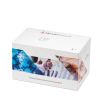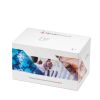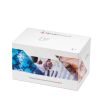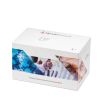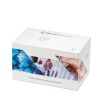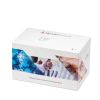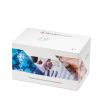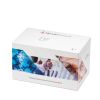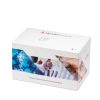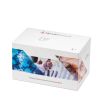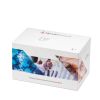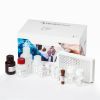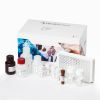Lactoferrin, Human, ELISA kit – 2 x 96 det. - HK329-02
Quantity
2 x 96 det.
Catalog #
HK329-02
1.153,00 €
Human lactoferrin (LF) is an 80 kDa glycoprotein found concentrated in the secondary granules of the neutrophils. In addition, lactoferrin can be found in epithelia and most body fluids and secretions. Lactoferrin was first isolated from human milk and plays an important part in the immune system by helping to fight infections. It has the ability to bind iron and possesses five different enzyme activities: DNase, RNase, ATPase, phosphatase, and malto-oligosaccharide hydrolysis. Lactoferrin is a natural anti-bacterial, anti-fungal and anti-viral protein, it is an antioxidant and also possesses immunomodulatory properties.
Furthermore, lactoferrin promotes the health of the gastro-intestinal system by improving the intestinal microbalance. Lactoferrin is secreted in plasma by neutrophils. Plasma of healthy individuals contains ~190-500 ng/ml LF. The lactoferrin plasma concentration represents a positive relation to the total pool of neutrophils and the rate of neutrophil turnover. Upon inflammation, lactoferrin is released from the secondary neutrophil granules into the extracellular medium. Therefore, the extracellular lactoferrin concentration can be used as an index for neutrophil activation. The iron binding property of lactoferrin is considered to be an important antimicrobial function. Human lactoferrin binds via its highly positively charged amino-terminus to bacterial products. It kills various bacteria, most probably by inducing intracellular changes in these bacteria without affecting the membrane permeability.
Cleavage by pepsin of lactoferrin leads to the release of lactoferricin H. This 47 amino acid peptide has more antimicrobial activity than its precursor and it can inhibit the classical but not the alternative complement pathway. Urine or breast milk of healthy persons contain ~30 ng/ml and ~500 µg/ml LF, respectively. During infection, the LF concentration can raise 10-100-fold. In faeces of healthy persons, ~1 µg/g LF can be detected, whereas in faeces derived from colon cancer or inflammatory bowel disease (IBD) patients, LF levels range from ~75-310 µg/g. Faecal lactoferrin is useful as a sensitive and specific marker in identifying intestinal inflammation such as Crohn's disease and IBD.
Combination of several markers, such as calprotectin, defensin, elastase, MPO, I-FABP and MAdCAM, may be useful for classifying IBD, as well as for identifying tumor grade and to confirm remission/response to treatment. Therefore, the Hycult Biotech Human Lactoferrin ELISA is a sensitive, non-invasive tool for monitoring disease activity.
| Datasheet URL | https://www.hycultbiotech.com/wp-content/uploads/2022/06/hk329-0819.pdf |
|---|---|
| Quantity | 2 x 96 det. |
| Quantity | 2 x 96 det. |
| Standard range | 0.4-100 ng/ml |
| Detection level | 0.4 ng/ml |
| Working volume | 100 µl/well |
| Species | human |
| Application | The human lactoferrin ELISA kit is to be used for the in vitro quantitative determination of human lactoferrin in plasma, urine, feces, breast milk and cell culture supernatant samples. |
| Principle | The human lactoferrin ELISA kit is a solid-phase enzyme-linked immunosorbent assay based on the sandwich principle with a working time of 3½ hours. Samples and standards are captured by a solid bound specific antibody. Biotinylated tracer antibody will bind to captured human lactoferrin. Streptavidin-peroxidase conjugate will bind to the biotinylated tracer antibody. Streptavidin-peroxidase conjugate will react with the substrate, tetramethylbenzidine (TMB). The enzyme reaction is stopped by the addition of oxalic acid. The absorbance at 450 nm is measured with a spectrophotometer. A standard curve is obtained by plotting the absorbance (linear) versus the corresponding concentrations of the human lactoferrin standards (log). The human lactoferrin concentration of samples, which are run concurrently with the standards, can be determined from the standard curve. |
| Storage and stability | Product should be stored at 4 °C. Under recommended storage conditions, product is stable for at least six months. |
| Precautions | For research use only. Not for use in or on humans or animals or for diagnostics. It is the responsibility of the user to comply with all local/state and Federal rules in the use of this product. Hycult Biotech is not responsible for any patent infringements that might result with the use of or derivation of this product. |
| References | 1. Lutykhina, I et al; Recombinant pseudoadenovirus nanostructure with the human lactoferrin gene: Production and study of lactoferrin expression and properties in vivo. Mol Gen Microbiology and Virology 2009, 24:32 2. Sarsu, S et al; The llace of calprotectin, lactoferrin, and high-mobility group box 1 protein on diagnosis of acute appendicitis with children. Indian J Surg January 2016 |
| Disease | Autoimmunity, Infectious diseases |
| Application assays: | The human lactoferrin ELISA kit is to be used for the in vitro quantitative determination of human lactoferrin in plasma, urine, feces, breast milk and cell culture supernatant samples. |
|---|---|
| Principle: | The human lactoferrin ELISA kit is a solid-phase enzyme-linked immunosorbent assay based on the sandwich principle with a working time of 3½ hours. Samples and standards are captured by a solid bound specific antibody. Biotinylated tracer antibody will bind to captured human lactoferrin. Streptavidin-peroxidase conjugate will bind to the biotinylated tracer antibody. Streptavidin-peroxidase conjugate will react with the substrate, tetramethylbenzidine (TMB). The enzyme reaction is stopped by the addition of oxalic acid. The absorbance at 450 nm is measured with a spectrophotometer. A standard curve is obtained by plotting the absorbance (linear) versus the corresponding concentrations of the human lactoferrin standards (log). The human lactoferrin concentration of samples, which are run concurrently with the standards, can be determined from the standard curve. |



